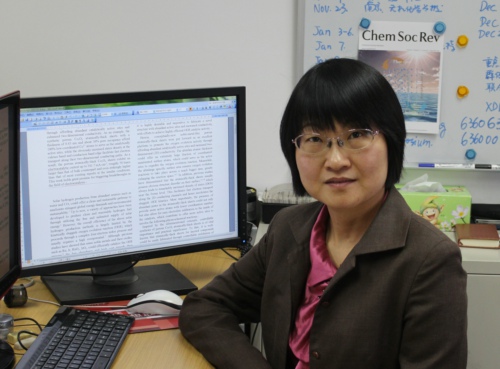A group of 62 elite Chinese and foreign scientists were formally inducted as members of the Chinese Academy of Sciences at a ceremony on Dec. 20th in Beijing. Two USTC professors, ZHAO Zhengguo and Xie Yi belonged to the 53 new Chinese honorees.
Brief Introduction:

ZHAO Zhengguo graduated from the Department of Modern Physics of USTC and received his Ph.D.in 1988. He worked as a postdoctor for the Beijing Spectrometer experiment (BES) at Beijing Electron Positron Collider (BEPC) at the Institute of High Energy Physics (IHEP) of CAS from 1988 to 1990. From 1990 to 1997, he was a postdoctor and research associate at Institute for Particle Physics (IPP) of Swiss Federal Institute of Technology (ETHZ). ZHAO was recruited to IHEP of CAS as the first “CAS 100 Talent Program” member of IHEP in 1997, and led the BES Collaboration and the Physics Division of IHEP. He jointed Physics Department of University of Michigan (UoM), as a visiting scientist and senior research scientist for the ATLAS experiment from 2001 to 2008. He was recruited to USTC as “National Thousand Talent Program” in 2008 and is now the director of the Center for Particle Science and Technology (CPST) of USTC.
During his stay at ETHZ, he and his collaborators precisely measured the strong interaction shift, and for the first time observed the energy broadening of the ground states of the pionic hydrogen and deuterium (exotic atoms). These results are still the most precise experimental data for the determination of S wave scattering length of pion and nuclear scattering, which are important physics quantities for the development and test of Chiral perturbation theory.
As the BES spokesperson and the director of the Physics Division of IHEP from 1997 to 2001, he successfully led the BES experiment. In addition, he directly led BES performed R scan – measurement of the R value with BESII in the energy region between 2 and 5 GeV. This experiment clarified the inconsistent results from different experiments and improved the accuracy about a factor of three. The results made great contribution to the indirect measurement of the Higgs mass from the Standard Model fit to the available electroweak data, and precision determination of the QED running coupling constant and the interpretation of the results of g-2 experiment. R scan done with BESII was regarded as one of the most important contribution to the high-energy physics. The results has been collected by PDG and written to the text book for high energy physics.
When worked at UoM, Prof. Zhao played an important role to the construction and commissioning of the ATLAS monitored drift tube (MDT) of the muon spectrometer. His great contribution was recognized worldwide in the ATLAS community. His interest for ATLAS experiment is search for Higgs and new physics beyond the SM, and physics with diboson.
Prof. Zhao has been re-elected to be the BES co-spokesperson since 2009 and his research interest with BES is search for exotic hadrons, new physics beyond the SM and charmonium physics.

XIE Yi received B.S. in Xiamen University (1988) and Ph.D. in University of Science and Technology of China (USTC,1996). In May 1996, she joined the faculty at the Department of Chemistry, USTC. She is now a Principal Investigator (PI) of Department of Nanomaterials and Nanochemistry, Hefei National Laboratory for Physical Sciences at Microscale and a full professor of Department of Chemistry, University of Science and Technology of China. She is also a recipient of many awards, including China Young Scientist Award (2002), China Young Female Scientist Award (2006), Chinese Academy of Sciences-Bayer Young Scientist Award (2003), the Cheung Kong Scholar, Ministry of Education (2000). Also now she is one of the International Advisory Editorial Board members of Dalton Transaction and Editorial Board member of Chinese Journal of Inorganic Chemistry, Journal of University of Science and Technology of China, and Chemistry Central Journal.
XIE and her group are pursuing cutting-edge research at four major frontiers, namely, nanotechnology, materials chemistry, energy science and theoretical physics. In particular, her research focuses on the preparation and assembly of inorganic functional nanomaterials and nanostructures. Recently her group started to move into the novel intelligent energy-saving fields by designing and preparation of nanohierarchitectures of inorganic phase change materials, aiming to the enhancement of temperature-induced smart switch in heat storage/release or infrared regulation. Now she is undertaking the National Basic Research Program of China (No. 2009CB939901), National Natural Science Foundation of China (No. 11079004, 90922016, 10979047), and innovation project of Chinese Academy of Science (KJCX2-YW-H2O). She is the corresponding author of more than 150 SCI papers including J. Am. Chem. Soc., Angew. Chem. Int. Ed., Adv. Mater., Adv. Funct. Mater., and Phys. Rev. Lett. .
(USTC News Center)